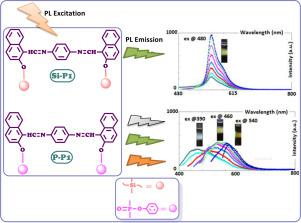Reactive & Functional Polymers ( IF 5.1 ) Pub Date : 2021-07-16 , DOI: 10.1016/j.reactfunctpolym.2021.104978 Süleyman Çulhaoğlu 1, 2 , Feyza Kolcu 1, 3 , İsmet Kaya 1

|
Polyazomethines including phosphate and silane groups were studied in this work. In the first step, two Schiff base monomers, SBs with two hydroxyl functional groups were synthesized as a result of a condensation reaction between diamine and aldehyde. Then, Schiff bases were polymerized by HCl elimination between hydroxyl groups of the SBs and chlorine of phenyl dichlorophosphate (P) or dichlorodiethylsilane (Si) to obtain two different polyazomethines for each. FT-IR, 1H NMR, 13C NMR and thermal analysis were utilized to characterize the synthesized SBs, P-polyazomethines and Si-polyazomethines. The optical band gap values (Eg) of the synthesized P-polyazomethines and Si-polyazomethines were calculated using UV–Vis spectrophotometer. The study of solvent effects on the absorption of P-polyazomethines and Si-polyazomethines was also included into this work. Low band gaps of the synthesized polyazomethines could be evaluated as semi-conductive material for the production of electronic and optoelectronic materials. Photoluminescence (PL) measurements revealed that P P1 gave a greenish-yellow color emission upon excitation at blue light of 480 nm with a 16.2% of quantum yield although the response of Si
P1 gave a greenish-yellow color emission upon excitation at blue light of 480 nm with a 16.2% of quantum yield although the response of Si P1 had white light emitting property. Besides, P
P1 had white light emitting property. Besides, P P2 had multicolor emission property and Si
P2 had multicolor emission property and Si P2 had white light emitting property. No obvious fluorescence changes were observed within 3600 s under the same conditions, serving as evidence of stability of PL emission of P
P2 had white light emitting property. No obvious fluorescence changes were observed within 3600 s under the same conditions, serving as evidence of stability of PL emission of P P1, Si
P1, Si P1, P
P1, P P2 and Si
P2 and Si P2 to be steady along with wavelength of the exciting light. Thermal properties of the synthesized polyazomethines indicated that they were thermal stable materials up to 300 °C. The residual of P-polyazomethines and Si-polyazomethines was observed between 39.8% and 64.7% at 1000 °C.
P2 to be steady along with wavelength of the exciting light. Thermal properties of the synthesized polyazomethines indicated that they were thermal stable materials up to 300 °C. The residual of P-polyazomethines and Si-polyazomethines was observed between 39.8% and 64.7% at 1000 °C.
中文翻译:

双偶氮甲碱衍生的磷酸盐和硅烷基共轭聚合物的合成:光物理和热表征
在这项工作中研究了包括磷酸根和硅烷基团的聚偶氮甲碱。在第一步中,由于二胺和醛之间的缩合反应,合成了两种席夫碱单体,即具有两个羟基官能团的 SB。然后,席夫碱通过 SB 的羟基与二氯磷酸苯酯 (P) 或二氯二乙基硅烷 (Si) 的氯之间的 HCl 消除进行聚合,以获得两种不同的聚偶氮甲碱。FT-IR、1 H NMR、13 C NMR和热分析用于表征合成的SB、P-聚偶氮甲碱和Si-聚偶氮甲碱。光学带隙值 ( E g) 合成的 P-polyazomethines 和 Si-polyazomethines 使用 UV-Vis 分光光度计计算。溶剂对 P-polyazomethines 和 Si-polyazomethines 吸收的影响的研究也包括在这项工作中。合成的聚偶氮甲碱的低带隙可作为用于生产电子和光电材料的半导体材料进行评估。光致发光 (PL) 测量表明, 尽管 Si
尽管 Si  P1的响应具有白光发射特性,但 P P1 在 480 nm 蓝光下激发时发出黄绿色光,量子产率为 16.2% 。此外,P
P1的响应具有白光发射特性,但 P P1 在 480 nm 蓝光下激发时发出黄绿色光,量子产率为 16.2% 。此外,P  P2 具有多色发光特性,Si
P2 具有多色发光特性,Si P2具有白色发光特性。在相同条件下,3600 s 内未观察到明显的荧光变化,证明 P
P2具有白色发光特性。在相同条件下,3600 s 内未观察到明显的荧光变化,证明 P  P1、Si
P1、Si  P1、P
P1、P  P2 和 Si
P2 和 Si  P2的 PL 发射随激发光波长稳定。合成的聚偶氮甲碱的热性能表明它们是高达 300 °C 的热稳定材料。在 1000 °C 下观察到 P-聚偶氮甲碱和 Si-聚偶氮甲碱的残留量介于 39.8% 和 64.7% 之间。
P2的 PL 发射随激发光波长稳定。合成的聚偶氮甲碱的热性能表明它们是高达 300 °C 的热稳定材料。在 1000 °C 下观察到 P-聚偶氮甲碱和 Si-聚偶氮甲碱的残留量介于 39.8% 和 64.7% 之间。



























 京公网安备 11010802027423号
京公网安备 11010802027423号